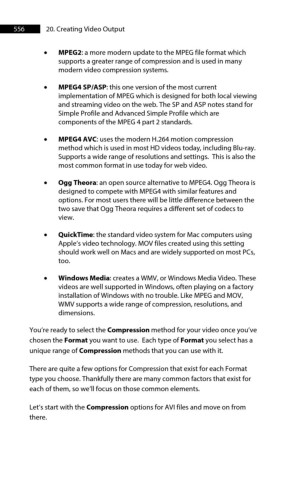Page 556 - ProShow Producer Manual
P. 556
556 20. Creating Video Output
• MPEG2: a more modern update to the MPEG file format which
supports a greater range of compression and is used in many
modern video compression systems.
• MPEG4 SP/ASP: this one version of the most current
implementation of MPEG which is designed for both local viewing
and streaming video on the web. The SP and ASP notes stand for
Simple Profile and Advanced Simple Profile which are
components of the MPEG 4 part 2 standards.
• MPEG4 AVC: uses the modern H.264 motion compression
method which is used in most HD videos today, including Blu-ray.
Supports a wide range of resolutions and settings. This is also the
most common format in use today for web video.
• Ogg Theora: an open source alternative to MPEG4. Ogg Theora is
designed to compete with MPEG4 with similar features and
options. For most users there will be little difference between the
two save that Ogg Theora requires a different set of codecs to
view.
• QuickTime: the standard video system for Mac computers using
Apple’s video technology. MOV files created using this setting
should work well on Macs and are widely supported on most PCs,
too.
• Windows Media: creates a WMV, or Windows Media Video. These
videos are well supported in Windows, often playing on a factory
installation of Windows with no trouble. Like MPEG and MOV,
WMV supports a wide range of compression, resolutions, and
dimensions.
You’re ready to select the Compression method for your video once you’ve
chosen the Format you want to use. Each type of Format you select has a
unique range of Compression methods that you can use with it.
There are quite a few options for Compression that exist for each Format
type you choose. Thankfully there are many common factors that exist for
each of them, so we’ll focus on those common elements.
Let’s start with the Compression options for AVI files and move on from
there.

